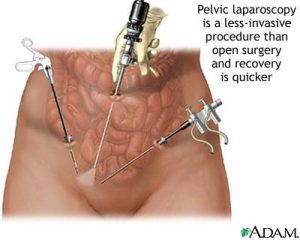Alternate Names : Tubal pregnancy, Cervical pregnancy, Abdominal pregnancy
Definition
An ectopic pregnancy is an abnormal pregnancy that occurs outside the womb (uterus). The baby (fetus) cannot survive, and often does not develop at all in this type of pregnancy.
Overview, Causes, & Risk Factors
An ectopic pregnancy occurs when a pregnancy starts outside the womb (uterus). The most common site for an ectopic pregnancy is within one of the tubes through which the egg passes from the ovary to the uterus (fallopian tube). However, in rare cases, ectopic pregnancies can occur in the ovary, stomach area, or cervix.
An ectopic pregnancy is often caused by a condition that blocks or slows the movement of a fertilized egg through the fallopian tube to the uterus. This may be caused by a physical blockage in the tube by hormonal factors and by other factors, such as smoking.
Most cases of scarring are caused by:
- Past ectopic pregnancy
- Past infection in the fallopian tubes
- Surgery of the fallopian tubes
Up to 50% of women who have ectopic pregnancies have had swelling (inflammation) of the fallopian tubes (salpingitis) or pelvic inflammatory disease (PID).
Some ectopic pregnancies can be due to:
- Birth defects of the fallopian tubes
- Complications of a ruptured appendix
- Endometriosis
- Scarring caused by previous pelvic surgery
The following may also increase the risk of ectopic pregnancy:
- Age over 35
- Having had many sexual partners
- In vitro fertilization
In a few cases, the cause is unknown.
Sometimes, a woman will become pregnant after having her tubes tied (tubal sterilization). Ectopic pregnancies are more likely to occur 2 or more years after the procedure, rather than right after it. In the first year after sterilization, only about 6% of pregnancies will be ectopic, but most pregnancies that occur 2 – 3 years after tubal sterilization will be ectopic.
Ectopic pregnancy is also more likely in women who have:
- Had surgery to reverse tubal sterilization in order to become pregnant
- Had an intrauterine device (IUD) and became pregnant (very unlikely when IUDs are in place)
Ectopic pregnancies occur in 1 in every 40 to 1 in every 100 pregnancies.
Pictures & Images
Pelvic laparoscopy
Laparoscopy is performed when less-invasive surgery is desired. It is also called “band-aid” surgery because only small incisions need to be made to accomodate the small surgical instruments that are used to view the abdominal contents and perform the surgery.
Ultrasound in pregnancy

The ultrasound has become a standard procedure used during pregnancy. It can demonstrate fetal growth and can detect increasing numbers of conditions in the fetus including meningomyelocele, congenital heart disease, kidney abnormalities, hydrocephalus, anencephaly, club feet, and other deformities. Ultrasound does not produce ionizing radiation and is considered a very safe procedure for both the mother and the fetus.
Female reproductive anatomy

External structures of the female reproductive anatomy include the labium minora and majora, the vagina and the clitoris. Internal structures include the uterus, ovaries and cervix.
Uterus

The uterus is a hollow muscular organ located in the female pelvis between the bladder and rectum. The ovaries produce the eggs that travel through the fallopian tubes. Once the egg has left the ovary it can be fertilized and implant itself in the lining of the uterus. The main function of the uterus is to nourish the developing fetus prior to birth.
Ultrasound, normal fetus – foot

This is a normal ultrasound of a fetus at 19 weeks gestation. The right foot, including the developing bones, are clearly visible in the middle of the screen.
Ectopic pregnancy

An ectopic pregnancy is one in which the fertilized egg implants in tissue outside of the uterus and the placenta and fetus begin to develop there. The most common site is within a Fallopian tube, however, ectopic pregnancies can occur in the ovary, the abdomen, and in the lower portion of the uterus (the cervix).
-
Ectopic pregnancy : Overview, Causes, & Risk Factors
-
Ectopic pregnancy : Symptoms & Signs, Diagnosis & Tests
-
Ectopic pregnancy : Treatment



Review Date : 2/21/2010
Reviewed By : Linda J. Vorvick, MD, Medical Director, MEDEX Northwest Division of Physician Assistant Studies, University of Washington School of Medicine; and Susan Storck, MD, FACOG, Chief, Eastside Department of Obstetrics and Gynecology, Group Health Cooperative of Puget Sound, Redmond, Washington; Clinical Teaching Faculty, Department of Obstetrics and Gynecology, University of Washington School of Medicine. Also reviewed by David Zieve, MD, MHA, Medical Director, A.D.A.M., Inc.
The information provided herein should not be used during any medical emergency or for the diagnosis or treatment of any medical condition. A licensed medical professional should be consulted for diagnosis and treatment of any and all medical conditions. Call 911 for all medical emergencies. Links to other sites are provided for information only — they do not constitute endorsements of those other sites. © 1997- 2010 A.D.A.M., Inc. Any duplication or distribution of the information contained herein is strictly prohibited.
